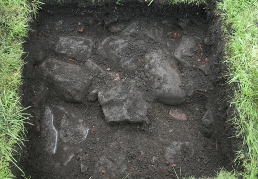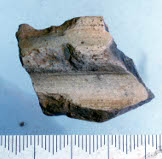Test Pits
 Test pits were dug around the village in 2007 and 2008 as a complementary method to the geophysical survey. These pits, predominantly of a standard 1m square, were designed to locate any surviving medieval deposits, and to quantify pottery distributions in order to gain some idea of the extent and date of the medieval village. Results from test pits within the vicinity of Haly Hill confirmed Leslie Alcock’s findings that no trace remained of any medieval deposits, either on the hill, or below in the alluvial floodplain.
Test pits were dug around the village in 2007 and 2008 as a complementary method to the geophysical survey. These pits, predominantly of a standard 1m square, were designed to locate any surviving medieval deposits, and to quantify pottery distributions in order to gain some idea of the extent and date of the medieval village. Results from test pits within the vicinity of Haly Hill confirmed Leslie Alcock’s findings that no trace remained of any medieval deposits, either on the hill, or below in the alluvial floodplain.  Study of the 18th-century accounts of the palace being washed away suggests these may be confusing the palace with later medieval buildings, and that the palace site lay elsewhere, possibly under the present manse or further south. The test pits in gardens on the north side of the village did produce medieval pottery, including Scottish White Gritty Ware of 12/13th century date, as well as green-glazed wares of later medieval date. However, all this material came from a buried medieval ploughsoil, indicating that the core of the medieval village lay closer to the present street line. In 2008 several further pits were excavated to the south of the village which produced little sign of medieval stratigraphy. These areas were mostly far from the village street. Although further areas remain to be investigated, the results so far have given us a good idea of limits of the medieval village, which is very similar to the present one, and has given us an indication of where the early deposits might survive.
Study of the 18th-century accounts of the palace being washed away suggests these may be confusing the palace with later medieval buildings, and that the palace site lay elsewhere, possibly under the present manse or further south. The test pits in gardens on the north side of the village did produce medieval pottery, including Scottish White Gritty Ware of 12/13th century date, as well as green-glazed wares of later medieval date. However, all this material came from a buried medieval ploughsoil, indicating that the core of the medieval village lay closer to the present street line. In 2008 several further pits were excavated to the south of the village which produced little sign of medieval stratigraphy. These areas were mostly far from the village street. Although further areas remain to be investigated, the results so far have given us a good idea of limits of the medieval village, which is very similar to the present one, and has given us an indication of where the early deposits might survive.

